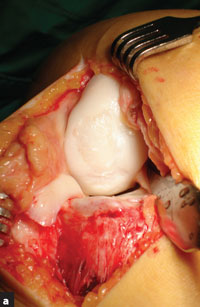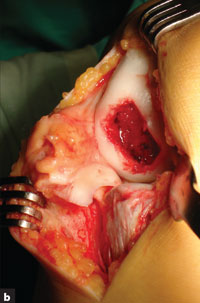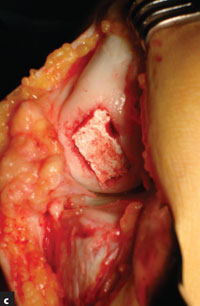Nanostructured scaffold shows promising results for treating osteochondral defects
Investigators found statistically significant improvements at 4 years of follow-up.
A minimally invasive one-step approach to treat osteochondral defects using a recently developed nanostructured scaffold layered with collagen and hydroxyapatite shows promising results as an easy and effective procedure, according to Italian researchers.
Elizaveta Kon, MD, presented the results of the clinical pilot study at the American Academy of Orthopaedic Surgeons 2012 Annual Meeting in San Francisco.
“The scaffold requires one surgical step. The most important thing provided is osteochondral repair,” Kon said during her presentation.

Elizaveta Kon
Kon and colleagues described in their abstract the scaffold preparation procedure as “enucleating equine collagen type 1 fibrils with hydroxyapatite nanoparticles in three different layers with three different gradient ratios at physiological conditions.” They conducted the study to test the scaffold’s effectiveness, safety and surgical reproducibility and to determine its potential for use without the aid of a cell culture.
The study included 30 patients with a mean age of 29.3 years who had chondral or osteochondral lesions of the knee measuring between 2 cm2 and 6 cm2 . All the patients underwent scaffold implantation between January 2007 and July 2007. The investigators measured patient outcome using the International Cartilage Repair Society standard cartilage evaluation form, the International Knee Documentation Committee (IKDC) subjective evaluation forms, the Tegner activity score and MRIs, evaluated through the 3-D magnetic resonance observation of cartilage repair tissue (MOCART) score. They evaluated patients at 6 months, 12 months and then yearly up to 4 years post-implantation.




The surgical technique used by the researchers is as shown: a) arthrotomic osteochondral defects exposure; b) implant site preparation; c) osteochodral scaffold implantation; and d) tourniquet release.
Images: Kon E
At the follow-up examinations, the investigators discovered statistically significant improvements in articular function and clinical scores from preoperative measures. They found that IKDC score improved from 40.4 at baseline evaluation to 71.5 12 months after the surgical procedure. The Tegner activity score improved as well, with stable clinical results confirmed up to 4 years. Using the MOCART score, the researchers calculated that cartilage defects were completely filled in 80% of the cases.
Researchers looked also for a correlation between clinical outcome and the different etiologies, and Kon noted that osteochondritis diseccans could be the “best indication” for the treatment because it was registered as “faster and better recovery” in patients with that condition compared to those with traumatic lesions. They also found that men achieved better results than women.
“We are waiting for long-term results for the scaffold,” Kon said. “However, for the user in these cases, it is important to restore biomechanics first and then think about cartilage reconstruction.” – by Renee Blisard
Reference:
- Kon E, Patella S, Filardo G, et al. Treatment of osteochondral defects: Pilot clinical study on a scaffold at 4-years follow-up. Paper #277. Presented at the American Academy of Orthopaedic Surgeons 2012 Annual Meeting. Feb. 7-11. San Francisco.
For more information:
- Elizaveta Kon, MD, can be reached at Biomechanics Laboratory, Instituto Ortopedico Rizzoli, Via Di Barbiano, 1/10-40136, Bologna, Italy; 39 051-636-6111; email: e.kon@biomec.ior.it.
- Disclosure: Kon is a paid speaker for Fidia and is a paid consultant for and owns stock in Cartiheal.
